|
Made With |
|
|
|
|
Dr. Hoffer's Travel WebSite This site was last updated 06/22/12 |
Limburg Flag
Wednesday June 10, 2009
At 2:20 AM I awoke from a vivid dream and didn't wake again until 9:30 AM. At 12
noon
I added �15 to my German phone using the prepaid cards and then got up at 12:15 PM.
It was a rainy day again but, with umbrella in hand, I went out and explored and
at 1:00 PM decided to have a "morning" cappuccino at Blanche Dael's "Coffeelovers"
[Dominikanerkerkstraat 1,
![]() +31-43�356-0832]
which is in an old Dominican church renovated into a massive book store called
Selexyz with a
delightful coffee shop inside.
+31-43�356-0832]
which is in an old Dominican church renovated into a massive book store called
Selexyz with a
delightful coffee shop inside.
Above are shots I took of the entrance with the caf� next door. Below left is a shot of the coffee service area near the apse where you sit to drink it. Below right is what you see above you.
Below are photos I took showing the crucifix-shaped table in the center of the old apse of the church where the altar used to be (left) and the circular chandelier hanging above it (center.) The central stacks of books takes the place of the pews in the nave (right.)
I have often said that England's Henry VIII and his boys were really stupid destroying all the English abbeys; the Spanish turned theirs into grand hotels called Posadas (as did the Portuguese calling them Pousadas) and here the Dutch have this marvelous bookstore, saving the architecture of this beautiful place. Below are stock photos of the ceiling paintings.
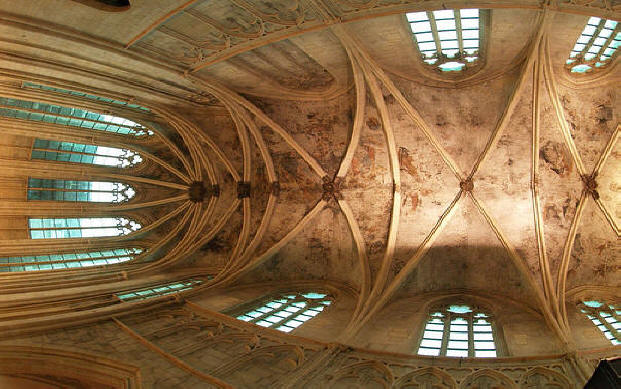
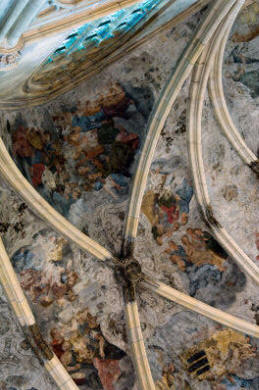
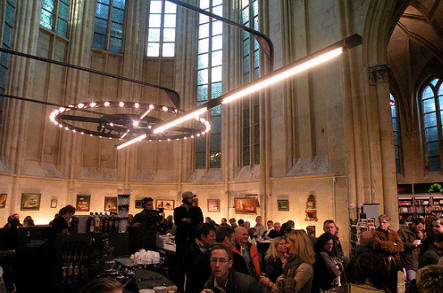
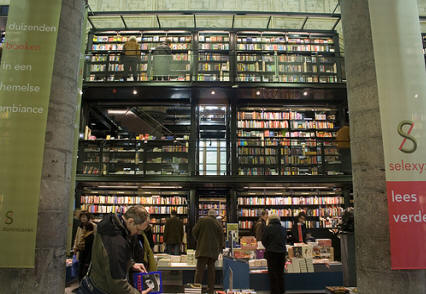
You can see how massive these three stories of books shelves are.
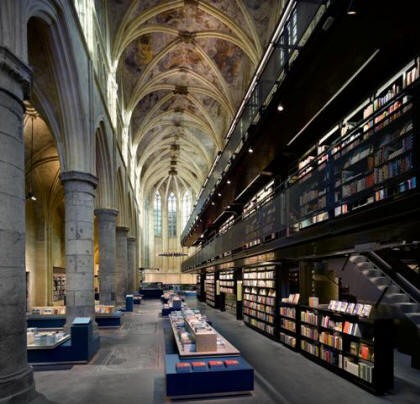
Above right is the caf� next to the bookstore which may have been a rectory or nunnery at one time. Below is another Blanche Dael coffeeshop.
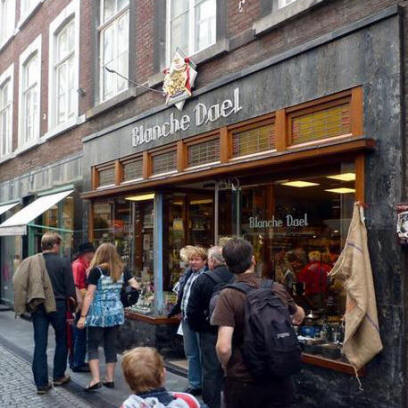
At 2:00 PM Marcia added �15 to her German phone chip and at 2:10 PM I started my research on the costs and values of the various Dutch phone chips.
T-Mobile (below left) was �10 for the number and you get �5 free talk time, Vodafone (below center left) was �9 with �4 free time and Hi-Society (below center right) was the same as T-Mobile. I also tried Telefoonkopen (below right) but the Asian guy working there was totally clueless and couldn't give me any information.
I
decided to go back to Vodafone (the cheapest) and stood in line for an eternity
and finally left in frustration. At 2:30 PM I walked back to the
Hi-Society store and easily bought two Dutch phone chips from a really nice chap
named Rolf (left with
white shirt) for �20 for both and also bought an additional �40 worth of top-up cards.
Rolf was very nice because
he carefully explained to me how to add new money to the chip without learning
how to speak Dutch - a big problem with some countries (especially France.)
I wandered all over the place since there was a calm in the rain and came across interesting things. Here is an example of a Dutch Post box (below left) and an novel way to say "Since 1340" (below right.)
.jpg)
There were several shops with interesting baked goods and sandwiches on display. Below is an example of one.
At 3:20 PM I went into
the tourist shop
they call the "VVV Tourist
Information" [Kleine Staat 1,
![]() +31-43-325-2121] located in a little door under the stairs in the Dinghuis building at the end of Grote Staat
(below) and bought a D-K book (right) on the city
of Maastricht as well as a bottle of the Apostella
wine (left,) the same exact wine we had last night but for much cheaper than we paid in the restaurant.
Usually they don't publish these great tour books for just a small city, but Limburg and
Maastricht paid them to do it for their area. It is very well done.
+31-43-325-2121] located in a little door under the stairs in the Dinghuis building at the end of Grote Staat
(below) and bought a D-K book (right) on the city
of Maastricht as well as a bottle of the Apostella
wine (left,) the same exact wine we had last night but for much cheaper than we paid in the restaurant.
Usually they don't publish these great tour books for just a small city, but Limburg and
Maastricht paid them to do it for their area. It is very well done.
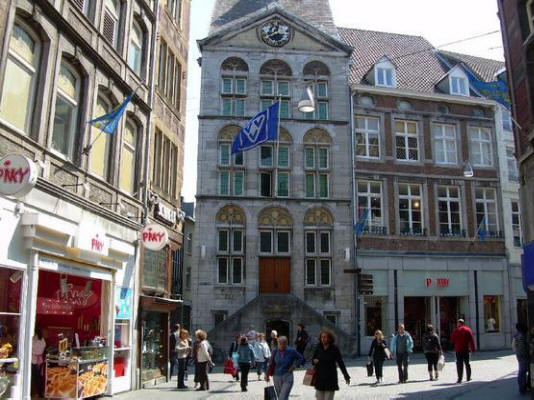
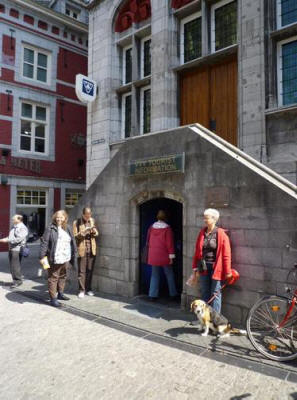
This historical building was built in 1460 in a Gothic style. The name Dinghuis is derived from the Dutch words �geding� (trial) and �huis� (house.) It originally served as a courtroom with prison cells in the basement (where the tourist office is now.) A watchman was stationed at the top of the tower to sound the alarm in case of a fire or other danger. The bell still functions today. Above and below is the doorway to the basement and below right is the interior of the tourist shop.
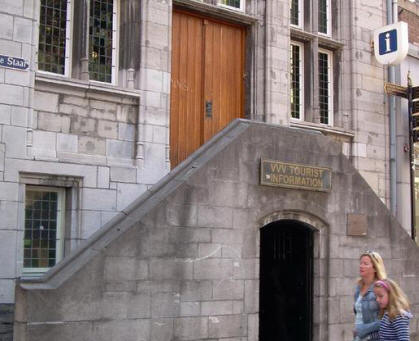
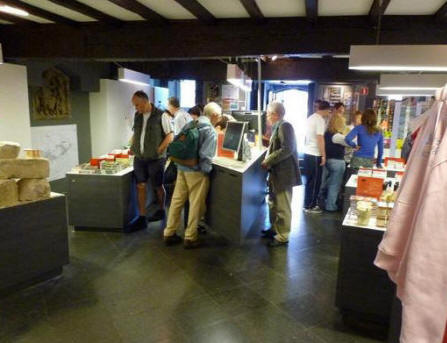
 Next door is a PINKY store
[Grote Staat 2,
Next door is a PINKY store
[Grote Staat 2,
![]() +31-43-321-9965] which offers some nice Belgian waffles as well as many other
sweets.
+31-43-321-9965] which offers some nice Belgian waffles as well as many other
sweets.
At 3:30 PM I stopped to have another
.jpg) cappuccino at
Grand Caf� Au Mouton
Blanc [Kersen-markt 10,
cappuccino at
Grand Caf� Au Mouton
Blanc [Kersen-markt 10,
![]() +31-43-321-5992]
which was very nice. The name means white sheep. It was not such much that I needed more coffee, but
more to sit inside a different place out of the drizzle and absorb the vibe of the people.
Below is the exterior (left) and inside the caf� (right.) Bavaria is
another popular beer here seen on many establishments.
+31-43-321-5992]
which was very nice. The name means white sheep. It was not such much that I needed more coffee, but
more to sit inside a different place out of the drizzle and absorb the vibe of the people.
Below is the exterior (left) and inside the caf� (right.) Bavaria is
another popular beer here seen on many establishments.
A little later, at 4:20 PM, Marcia had a lunch of Ham und Kaas (cheese) at Brasserie Rubens Uitsm. Here is a passage from a blog I found by an English (UK) traveler to Maastricht:
"Between the Vrijthof Square and the railway station, you'll find a variety of shops, trendy boutiques and department stores. Men should be warned that the shopping possibilities in Maastricht are endless, a fact quickly detected by my wife's in-built spending antennae which, it seems, are directly linked to the hi-tech chip on her credit card."
Well, I never saw that warning and it just
so happened that Marcia
went
on a shopping venture getting shoes at Munnichs [Grote Staat
56,] hair supplies at Claire's [Grote Staat
44,] cosmetics at Douglas [Grote Staat
26] and a purse at Bijou Brigitte [Grote Staat 61.] I think she had a good
afternoon. Below are photos of this Grote Staat, which I believe means
Grand Street. Below right is another shot of the
Dinghuis building at the end of the
street.
Everywhere I looked there were signs in the store windows based on this recession we're all in - everything was on sale and prices are being slashed.
 I walked down Stokstraat and at the end I came across
Grand Cafe d'Artagnan [Graanmarkt 3,
I walked down Stokstraat and at the end I came across
Grand Cafe d'Artagnan [Graanmarkt 3,
![]() +31-43-325-5164, info@cafedartagnan.nl]
named after d'Artagnen, the famous 4th musketeer who died here in Maastricht.
+31-43-325-5164, info@cafedartagnan.nl]
named after d'Artagnen, the famous 4th musketeer who died here in Maastricht.
Below (left) on the wall, you can see their mural (right) of the great musketeer having a good time.
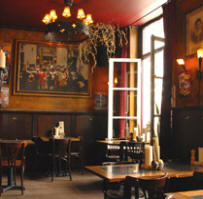
![]()
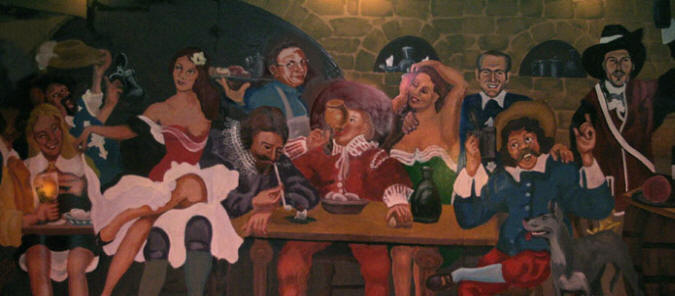
I made my way to the other end of Stokstraat and came across this sculpture of a boy with his dog sitting atop the short brick wall. The boy is named Pieke from a book by Ber Hollwijn.
Then I came across this building (below left) which contains a little caf�
called La Bonne Femme [Graanmarkt 1,
![]() +31-43-321-6861]. Here is another church.
+31-43-321-6861]. Here is another church.
Then I found this elaborate cake display in a bakery window (below left) I just had to photo. As I ambled about I took a shot of this interesting brick carving of a fox on the side of a building labeled "Au Renard, bon logis 1737" (below right.)
.jpg)
This is a better shot I found on the
internet.
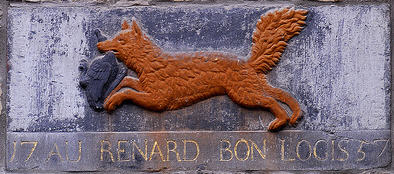
As you can see below, the city is filled with these everywhere (18th Century.)
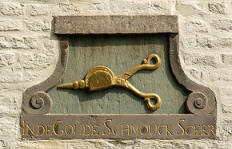
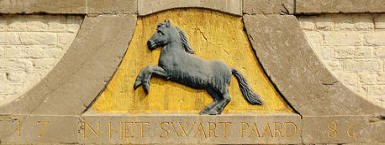
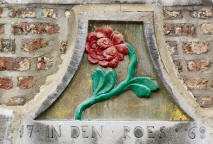
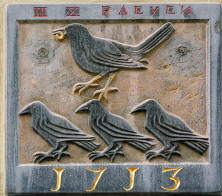
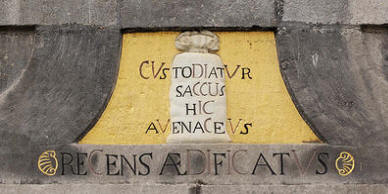
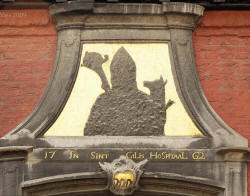
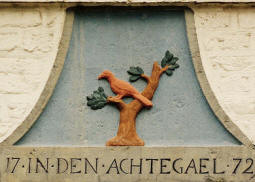
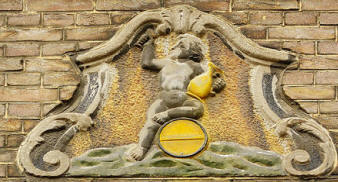
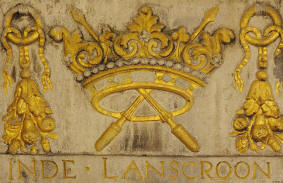
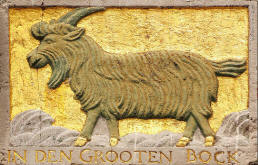
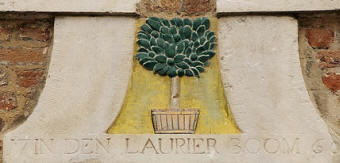
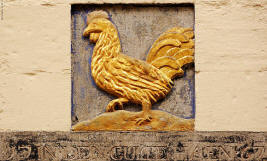
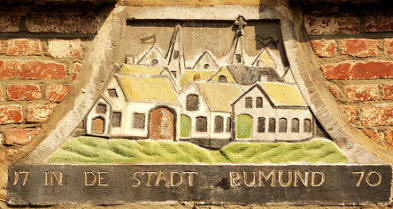
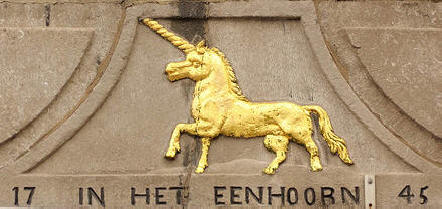
[The above 15 amazing shots are by Wies de Leeuw-Akkermans of Rosmalen, the Netherlands.]
Then, at the corner of Koestraat and Cortenstraat, I came across this line of eateries and pubs stretching down Koestraat (below.)
I wandered back to Onze Lieve Vrouweplein (Our Lady square) where we went to dinner the night before last. The restaurant (t'Kl��ske) we went to (below) is right next door to...
...a fancy
4-star
hotel called
Hotel Derlon (below left, stock photo left) [Onze Lieve Vrouweplein 6,
![]() +31-43-325-1933] that also has a nice restaurant inside called
Restaurant Zes
(below right) [
+31-43-325-1933] that also has a nice restaurant inside called
Restaurant Zes
(below right) [![]() +31-43-321-6770.] I went inside and noticed how nice it was but there was
no one inside having lunch, so maybe it is setup more for dinners.
+31-43-321-6770.] I went inside and noticed how nice it was but there was
no one inside having lunch, so maybe it is setup more for dinners.
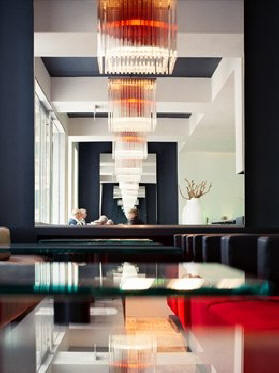
Below is a Photostitch shot of the famous square with many places to relax and get something to eat.
The massive church (below left) Onze-Lieve-Vrouwebasiliek is just on the far right (above) and below.
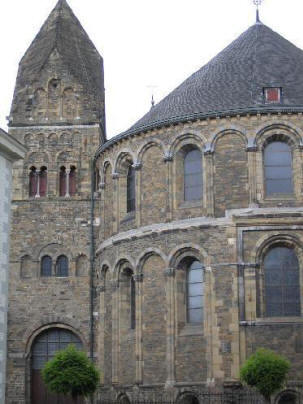
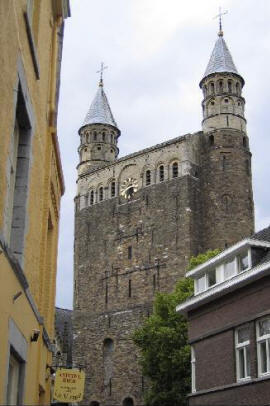
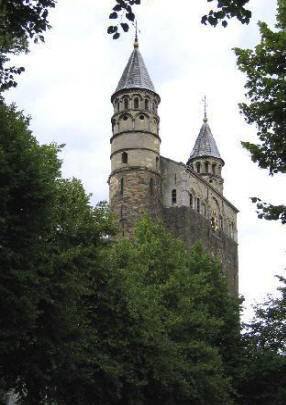
It is an impressive building looking like a fortress. I entered the door (below) to the little chapel that houses...
...the votive statue of Our Lady "Sterre der Zee" (Star of the Sea.)
Above and below left are the shots I took and on the right (below) are stock photos of the visit here by Pope John Paul II in May 1985.
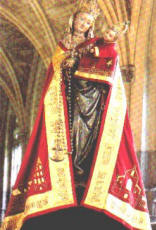
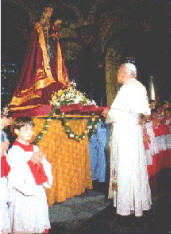
Below left is the entrance to Onze Lieve Vrouwekerk (Our Lady Church) which is located on the other side of the building. The apse (below right) is quite spectacular (stock photos.)

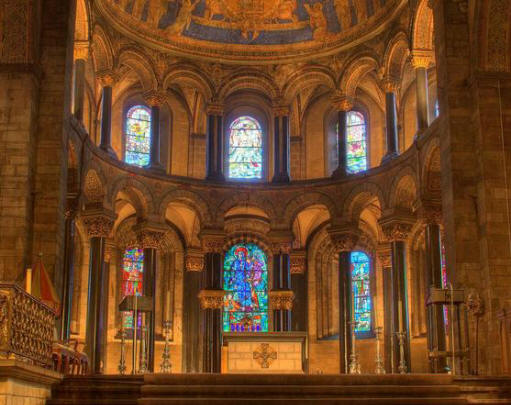
Below left shows the size of this church and below left is a work by Jan Van Steffensweert inside the church.
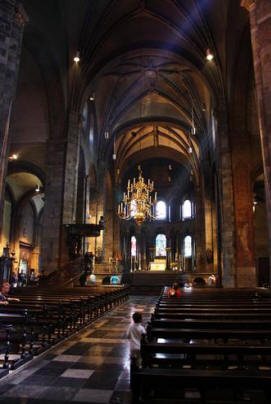
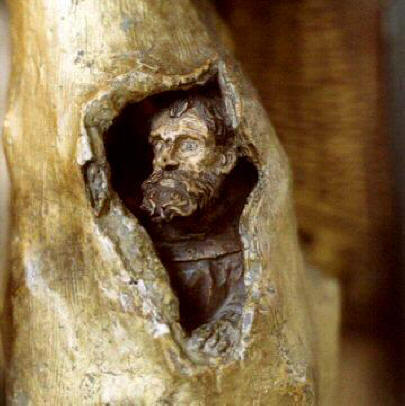
Below left is a stock photo of the present pastor, Msgr. dr. A. Kurris. On my way out there was this royal bed (center) and medieval stone carvings in the wall (right.)
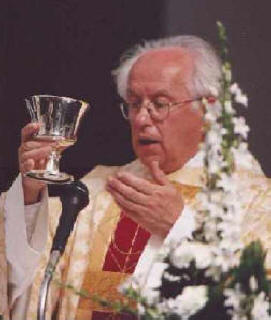
Then I headed west, back to the neighborhood of our hotel. I wandered my way over to try to get into the St. Servaas church but it was closed. It was declared a basilica by Pope John Paul II when he visited Maastricht in 1985. Below right is the street along one side of the church.
In the rain, I came across this bronze statuary of two bishops (below) on a pedestal right next to the big church.
The inscription on the pedestal states "Monulphus en Gondulphus: Bouwers van de magnum templum 6 eeuw boven het graf van St. Servaas" which means "St. Monulphus and St. Gondulphus: Builders of the Magnum Templum in the 6th Century above the tomb of St. Servaas." Below is my shot of the two churches; St. Janskerk on the left and St. Servaas on the right.
These are the close-ups I took of both churches.
Since the church was closed when I arrived, the next 15 photos of the interior are stock photos I found to show the interior.
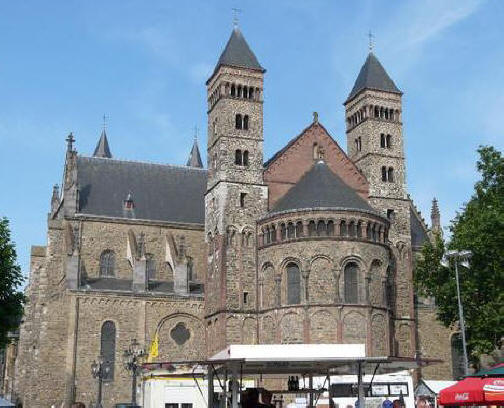
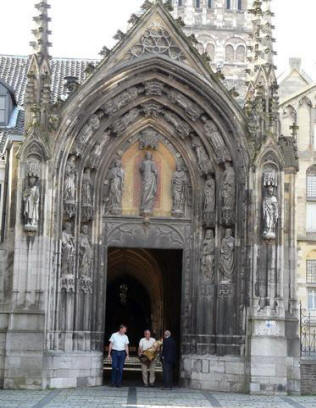
St. Monulphus was Bishop of nearby Tongres and he moved the bishopric to Maastricht and had the church of St. Servaas built as a stone church over the previous one and they simply called it Magnum Templum (meaning "large temple".) He died at the end of the 6th Century and his successor was St. Gondulphus who died in 607 AD. In 1039 AD, the year the church was consecrated, they were both exhumed by the bishop at that time. Above right is the south gate entry and below left is the statues above the door showing Christ flanked by St. Peter and St. Servaas.
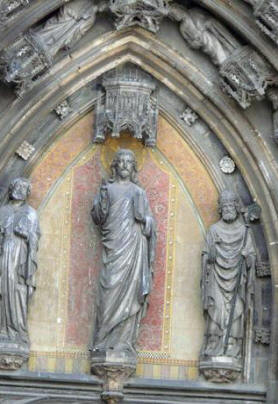
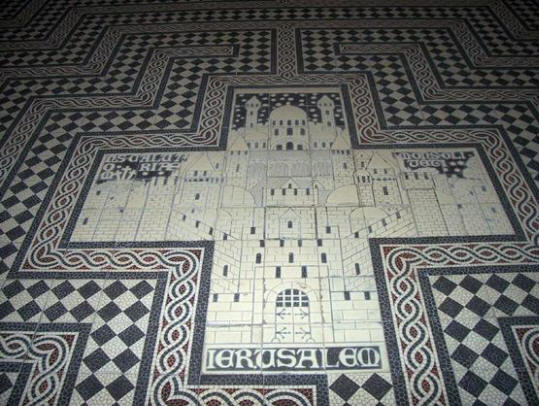
As you enter the foyer of the south gate, you see this amazing mosaic flooring (above right) showing the basilica inside a cross. Along side, the walls is beautiful brick work with alcoves holding statues of saints (below left.) The entry to the church is also quite detailed (below left.)
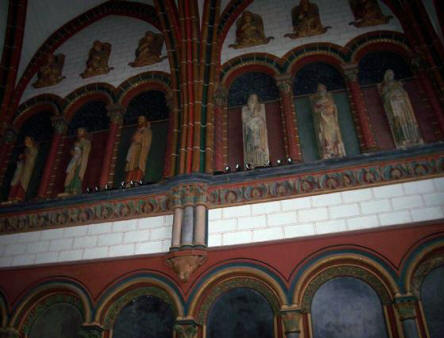
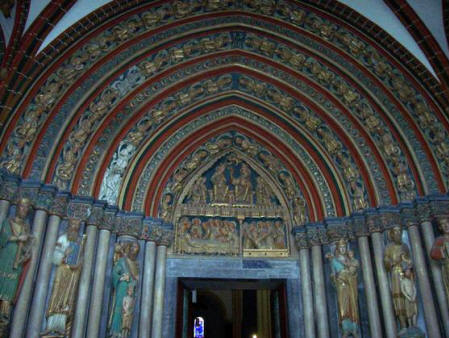
Here is a layout of the basilica.
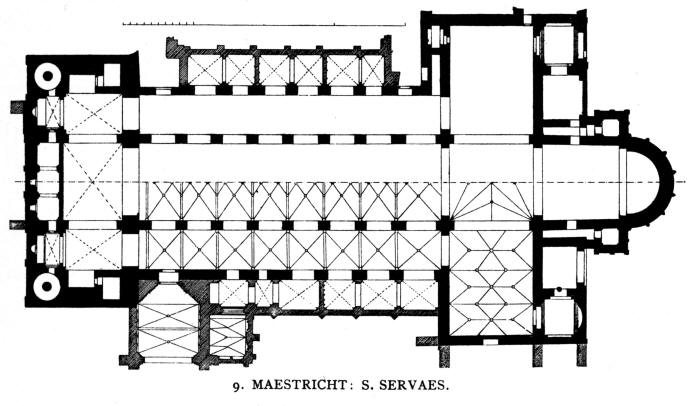
Once you enter the main nave (below left,) you see the main aisle with this spectacular chandelier. The main nave is 174 ft (53m) long, 36 ft (11m) wide, and 70 ft (21m) high. Approaching the altar reveals the large hanging cross and the ceiling of the apse (center.) The stained glass windows are also very nice.
.jpg)
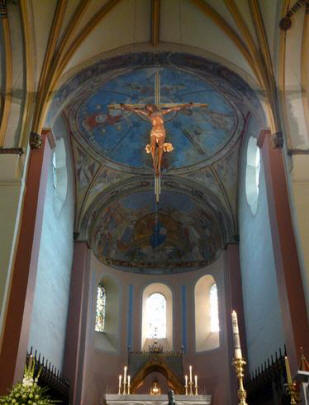
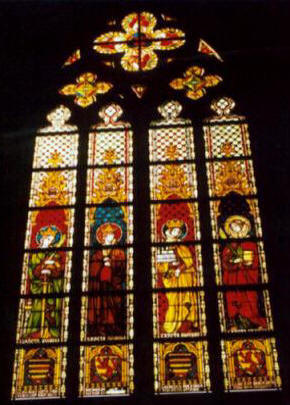
Below is a photo of the mural on the ceiling of the apse. Interesting is the brown ribbon with symbols of the zodiac along the bottom. There is also a statue of Carolus Magnus (or Karl the Great,) by Willem Geefs from 1843.
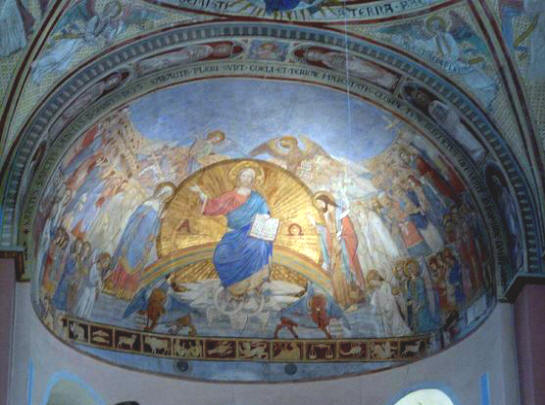
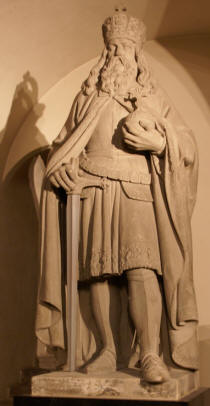
Below are some of the religious items inside the basilica (stock photos.)
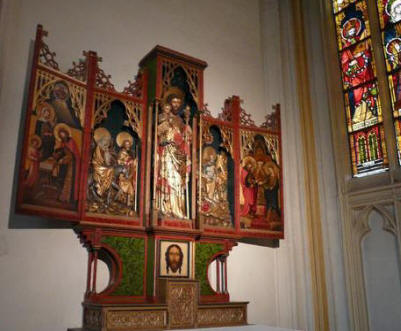
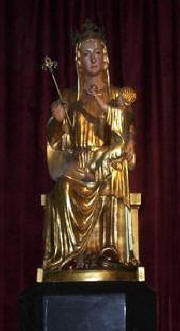
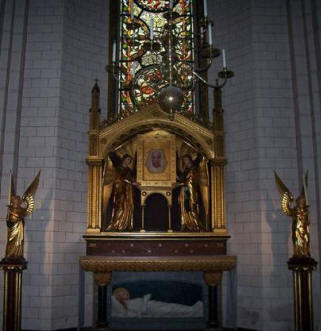
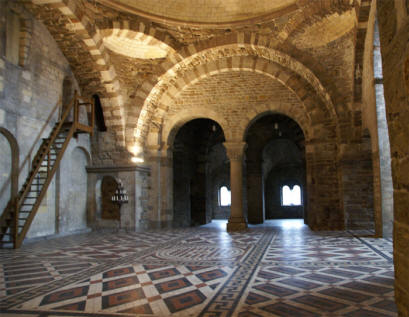
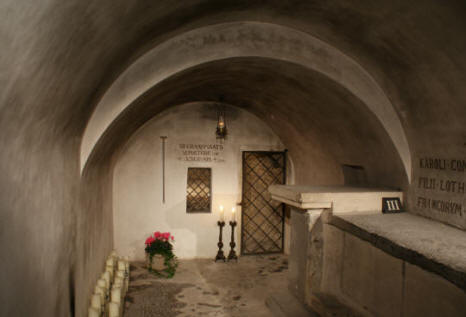
The room above left is called Emperor's Hall and the crypt (above right) is the
location where Saint
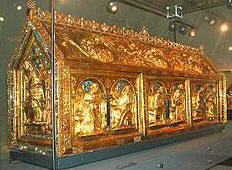
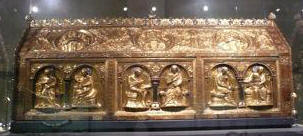 Servaas
was buried in 384 AD. In the Treasury (Schatkamer) is the reliquary that
holds the remains of St. Servaas. It is called the Noodkist which dates
from 1160 AD and was led in a procession through the streets of the city in dire
times; now it is done routinely every 7 years.
Servaas
was buried in 384 AD. In the Treasury (Schatkamer) is the reliquary that
holds the remains of St. Servaas. It is called the Noodkist which dates
from 1160 AD and was led in a procession through the streets of the city in dire
times; now it is done routinely every 7 years.
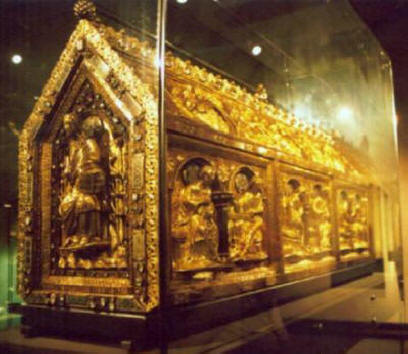
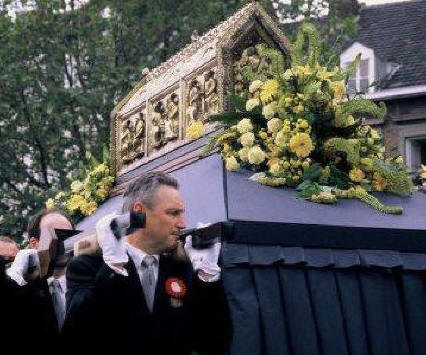
Below left is a metal bust of St. Servaas from the Treasury. There is also the great bell of St. Servaas called the "Grameer" (or the "Grandma") which hung in the Southern Tower (center) and is the largest bell in the Netherlands. The bell was made in 1515 AD and weighs about 7.25 tons (6600 Kg.) It was moved (right) in 1983 and thus silenced forever.
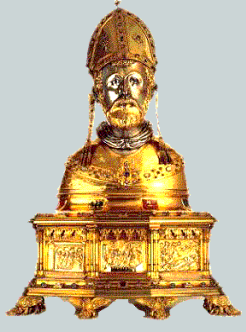
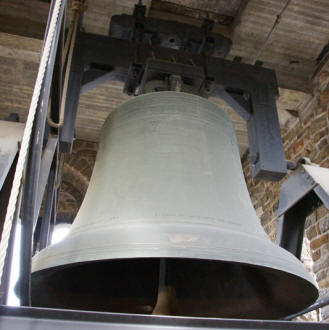
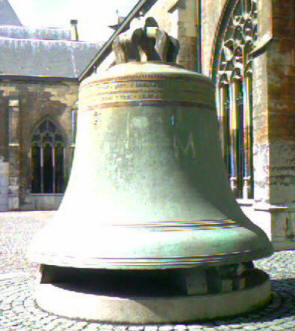
History says the Vikings destroyed the church in 880 and it was rebuilt again around the year 1000 AD. I then got these shots of St. Janskerk church next door. You can climb the steeple here for a fee but it was also closed.
.jpg)
This was an interesting doorway (below) and a statue of the Virgin Mary labeled "Toon G'j onze moeder z'jt" meaning "Show that g' j our mother z' jt."
.jpg)
After leaving the church I walked around some more and came across the Grand
Theater Caf� (below) also called
La Bonbonni�re [Achter de Comedie 1,
![]() +31-43-350-0935] which is noted for Belgian cuisine.
+31-43-350-0935] which is noted for Belgian cuisine.
It is a Theater-Caf� and quite luxurious as
can be
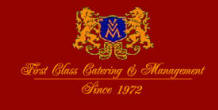 seen
by the stock photos below. It is run by the VVM Group which is
headquartered in the Chate�u de la Motte in
France, 12 miles south of Troyes (below below left.) They also run the
famous Peterhof Palace (below below right) just outside of St. Petersburg in
Russia which we visited in 2003 (see SCAND2003 Trip.)
seen
by the stock photos below. It is run by the VVM Group which is
headquartered in the Chate�u de la Motte in
France, 12 miles south of Troyes (below below left.) They also run the
famous Peterhof Palace (below below right) just outside of St. Petersburg in
Russia which we visited in 2003 (see SCAND2003 Trip.)
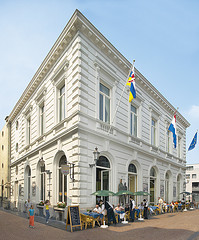
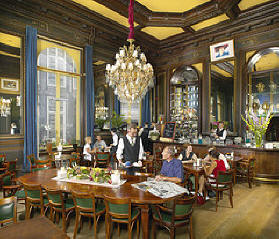
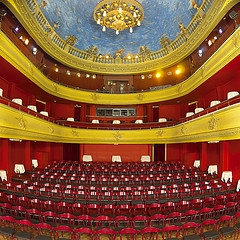
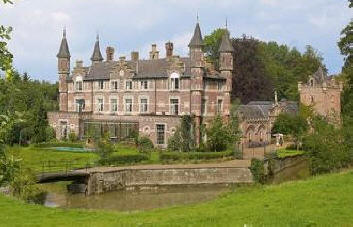
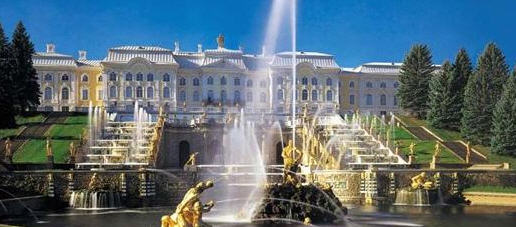
Here are more examples of the eateries around this town.
Below left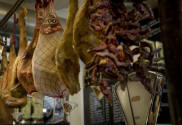 is a closer shot showing the Lunette Pizza Ristorante [Platielstraat]
and the Spanish restaurant which is called
La Bodega
[Platielstraat 9,
is a closer shot showing the Lunette Pizza Ristorante [Platielstraat]
and the Spanish restaurant which is called
La Bodega
[Platielstraat 9,
![]() +31-43-350-0633.]
You can see the photo (right) of the famous Spanish hams (jamons) hanging up in
the restaurant.
+31-43-350-0633.]
You can see the photo (right) of the famous Spanish hams (jamons) hanging up in
the restaurant.
Below is
Edd's Caf� [Heggenstraat
3,
![]() +31-43-352-1717, info@edds-cafe.nl] for
"Eat-Dance-Drinks."
+31-43-352-1717, info@edds-cafe.nl] for
"Eat-Dance-Drinks."
This is a shot I took of the other side of the Vrijthof plaza, the street that is lined with one restaurant after another (covered by trees.)
Below is one of the eateries called Cafe Metropole [Vrijthof 8,
![]() +31-43-321-1937.] The umbrellas were not to keep the sun
out; it just kept raining.
+31-43-321-1937.] The umbrellas were not to keep the sun
out; it just kept raining.
.jpg)
I went back to the room and changed and at 5:50 PM I did my run with an umbrella over to the St. Servaasbrug (bridge) across the Maas River to end at Wijck Station.
.jpg)
The Sint Servaasbrug (St. Servaas bridge) is a pedestrian bridge which links the city centre of Maastricht at the western side of the Maas River with the Wijck district on the east side. Below left is the view heading to Wijck and on the right is the view heading back to town.
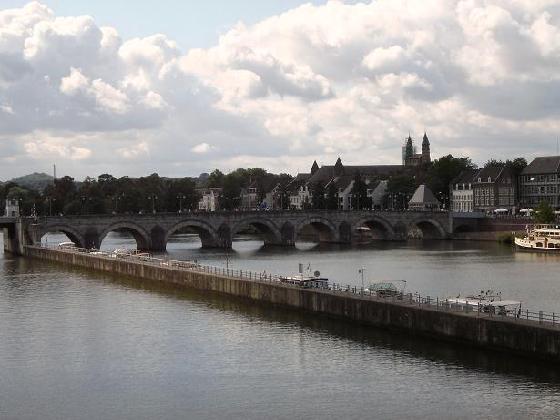
Below are views looking north (left) and south (right) from the middle of the bridge.
This bridge may be the oldest bridge in the Netherlands. The original Roman bridge was replaced by a wooden one which collapsed in 1275 during a procession in which more than 400 people died. In 1280, they began building the present bridge of stone. This bridge first had a wooden part on the eastern side, which could be moved away in case of danger. In 1932 that section was replaced with one that can be raised for tall ships.
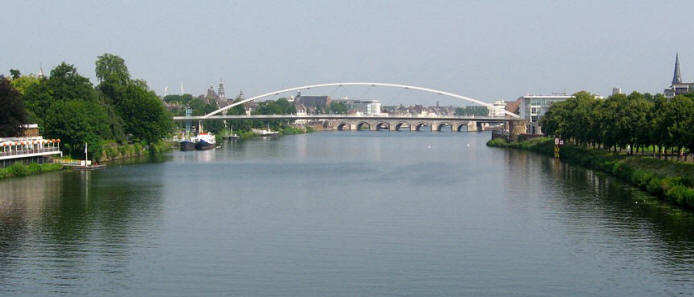
Above (stock photo) and below left is a far off view of Den Hoeg Br�gk or the "loopbrug," an 856 ft (261 m) pedestrian/bicycle bridge built in 2003 south of this one. Beyond that is the J.F. Kennedy Brug and north of here is the Wilhelminabrug, both for car traffic. Below right is a view of entering the St. Servaas bridge heading to Wijck. There is a souvenir shop in the little building on the right of the bridge.
The Helpoort or "Hell's gate" (below,) built in 1229, is the oldest surviving town gate in the Netherlands. It was part of the oldest fortifications of Maastricht. In the 15th Century a newer fortification was built south of the town gate. You can visit the Helpoort to climb the tower and explore a small historical exhibition. Below right is a view of the street from the tower.
[Next 7 shots are stock photos.]
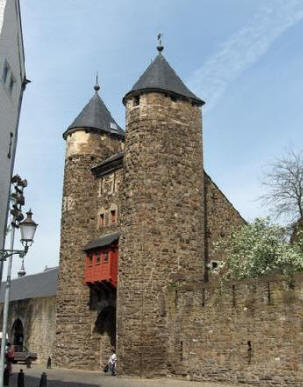

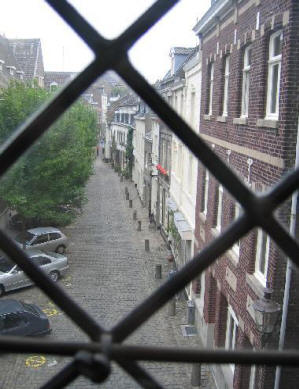
Below are shots of the tower gate from both sides.
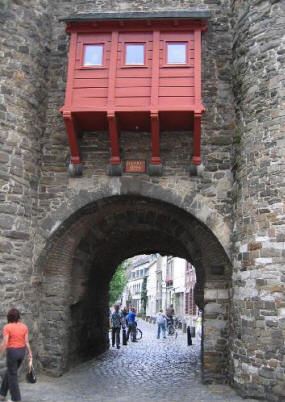

The Onze Lieve Vrouwe Wal (wall) along the Maas River is part of the first fortifications of Maastricht. The wall was built in 1229 at the same time as the Helpoort at its southern end. You can get a good view of it by walking from the Sint Servaas bridge along the riverbank to the Helpoort or the park. In front of the wall is a row of old canons (below left.)
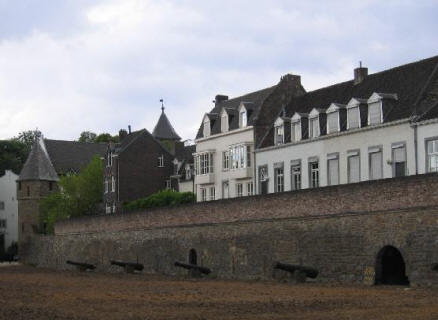
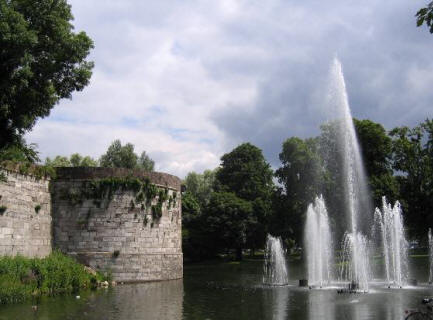
In 1516 the fortifications of Maastricht were enlarged with two bastions (above right) because of the development of a new type of canon which needed more room around it to use it. The names of the two bastions are "Vijf koppen" (the five heads) and "Haet ende Nijt" (hate and envy.) The first bastion is named after the 5 heads of Father Servaes Vinck and four other condemned men which were placed in this bastion after their execution in 1658 for the alleged treason of informing the Spanish invaders.
You can walk down into the park which has a nice view of the fortifications from the outside. You can also climb up the walls and fortifications where you can get a good view of the park and its canons. Between the two bastions there is the Poort Waerachtig which was built more recently in 1888.
On the other side of the bridge, I arrived in the Wijck area which lies between the Maas River and the railway station opposite the old city center. The name Wijck comes from the Roman Latin word "Vicus," meaning suburb, because that is what it was in Roman times. In Wijck you can find some wide avenues lined with trees and large houses similar to those you might see in Bruselles or Paris. There are also some interesting restaurants and shops. Wijck was also known for the brewery here, where they produced Wieckse Witte beer, but it closed in 2003. I reached the main intersection with a large column in the center holding a bronze statue and ...
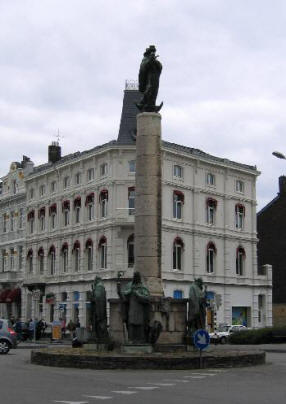
...four bronze statues at the base. There were many stately buildings in this area.
On one corner (below) is the
Hotel Beaumont [Wycker
Brugstraat 2, ![]() +31-43-325-4433,
info@beaumont.nl] with its caf� outside
and the statue of the sliced man in front. The hotel was opened in 1912 by
William Beaumont the grandfather of the present owner and has been completely
refurbished many times. It's quite a nice place and reasonably priced.
+31-43-325-4433,
info@beaumont.nl] with its caf� outside
and the statue of the sliced man in front. The hotel was opened in 1912 by
William Beaumont the grandfather of the present owner and has been completely
refurbished many times. It's quite a nice place and reasonably priced.
Below is my shot of the comical bronze sculpture of a sliced man which might be a comment about the weather around these parts.
Then on another corner there is the
Amr�th Grand Hotel de
l'Empereur [Stationsstraat 2, ![]() +31-43-321-3838] (below left)
+31-43-321-3838] (below left)
and Hotel "Le Guide" [Stationsstraat 17A,
![]() +31-43-321-6176] (below right.)
+31-43-321-6176] (below right.)
I finally arrived at my farthest extent, at the Maastricht railway station.
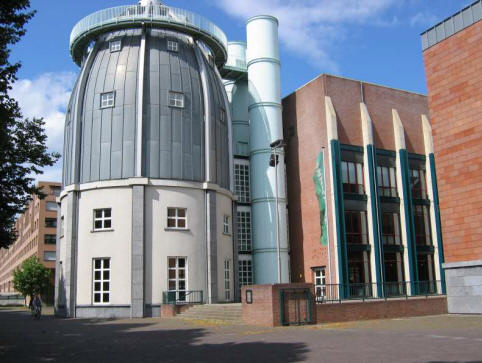
The Bonnefanten Museum [Avenue
Ceramique
250,
![]() +31-43-329-0190] (above right) displays fine art of the old masters from the 16th and
17th Century Flemish painting period, including major works by Rubens, Van Dyck and
Jordaens, as well as contemporary American minimal art and Italian Arte Povera
(art of the poor.) Examples are the "Temptations of
St. Anthony" by David Teniers de Jonge from 1640 (below left) and "Cimon en Pero" by
Ruebens from 1630 (below right.)
+31-43-329-0190] (above right) displays fine art of the old masters from the 16th and
17th Century Flemish painting period, including major works by Rubens, Van Dyck and
Jordaens, as well as contemporary American minimal art and Italian Arte Povera
(art of the poor.) Examples are the "Temptations of
St. Anthony" by David Teniers de Jonge from 1640 (below left) and "Cimon en Pero" by
Ruebens from 1630 (below right.)
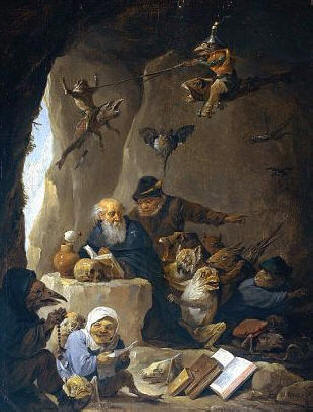
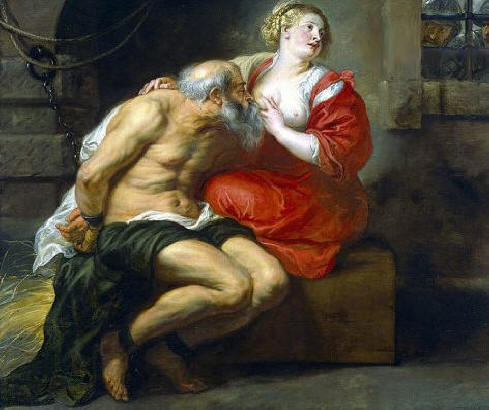
Below left are statues of St. Gregory (left) and St. Anthony (right.) Center is a painting of St. Stafanus (Stephen) by Giovanni del Biondo (1356-99.) Below right is a beautiful medieval wood carving of the burial of Christ.
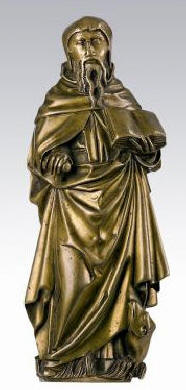
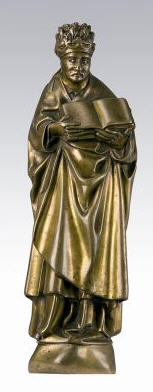
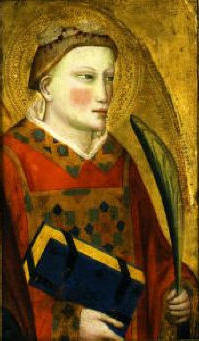
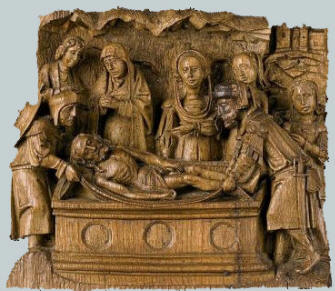
Here are some ivory medieval religious carvings.

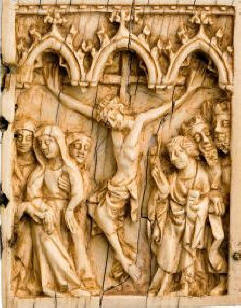
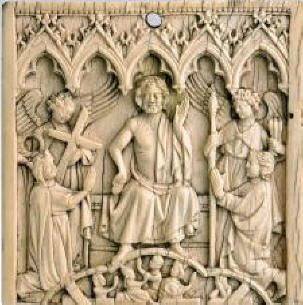
They also have still lives, porcelain statues and this painting of Pan.
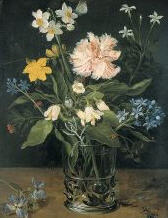
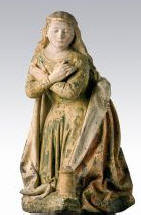
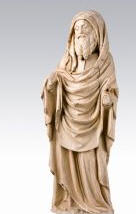
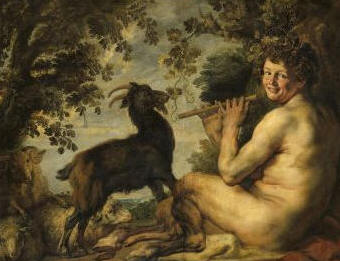
This museum was designed by the Italian architect Aldo Rossi. The imposing cupola dome of the museum lies alongside the Maas River and became one of Maastricht's major landmarks. From the entrance on the other side, the symmetrical building looks like an Egyptian temple. The collection also includes examples of Maastricht silver, projections, large ensembles and room-size installations.
Another important building is the Centre C�ramique
[Avenue C�ramique 50,
![]() +31-43-350-5600] which was designed by architect Jo Coenen.
+31-43-350-5600] which was designed by architect Jo Coenen.
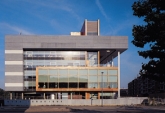
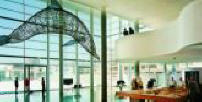 The city's main
library is housed in this building. It is also a modern cultural center
and a meeting place. There are all kind of exhibitions such as a
collection of local pottery, the provincial archaeological collection, the
replica of the "Parisian" scale-model of Maastricht (1750) and the scale-model
of the C�ramique area.
The city's main
library is housed in this building. It is also a modern cultural center
and a meeting place. There are all kind of exhibitions such as a
collection of local pottery, the provincial archaeological collection, the
replica of the "Parisian" scale-model of Maastricht (1750) and the scale-model
of the C�ramique area.
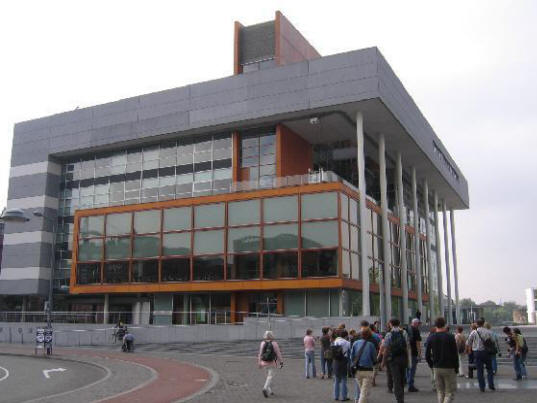
They also hold lectures and concerts here and people come here for a drink, to read or have lunch.
I ultimately arrived at the major street, Rechtstraat,
where
all the upscale businesses are. Below is looking south (left) and north
(right.) In some places the cars are parking up on the sidewalk and in
others there are metal post barriers preventing that.
As you can see below, they put the name of the street in the pavement along with the city's symbolic star. Not a bad idea. Below right you can see how nicely the sidewalks are "tiled."
By 6:20 PM I was walking along Rechtstraat
and found several nice restaurants: Below are:
Left: O
Restaurant [Rechtstraat 76,
![]() +31-43-325-9747,]
+31-43-325-9747,]
Center:
Mediterraneo
[Rechtstraat 73, ![]() +31-43-325-5037]
+31-43-325-5037]
Right: Les Marolles [
" 88a,
![]() +31-43-325-0447, lesmarolles@planet.nl.]
+31-43-325-0447, lesmarolles@planet.nl.]
O also runs Restaurant R"O"zemarijn [Havenstraat 19,
![]() +31-43-450-6505]
on the other side of the river.
+31-43-450-6505]
on the other side of the river.
I happened into a Indonesian restaurant nearby called
Gembira Indonesische Specialiteiten
Traiteur [Rechtstraat 33, ![]() +31-43-321-2451] and I took a shot of their array of
offerings (below.)
+31-43-321-2451] and I took a shot of their array of
offerings (below.)
.jpg)
I
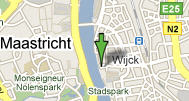 finished
my running and fast walking and wound up in an area south of Rechtstrat and in
front of this beautiful hotel right next to the river. It was the
Crowne Plaza Hotel [De Ruiterij 1,
finished
my running and fast walking and wound up in an area south of Rechtstrat and in
front of this beautiful hotel right next to the river. It was the
Crowne Plaza Hotel [De Ruiterij 1, ![]() +1-877-270-1395] and I went inside to inquire about their
room rates which weren't bad for a 4-star hotel. The receptionist (below
right) offered me one of their free drinks (below right) that they had sitting
out for guests; it was a little weird and I don't know what it was.
+1-877-270-1395] and I went inside to inquire about their
room rates which weren't bad for a 4-star hotel. The receptionist (below
right) offered me one of their free drinks (below right) that they had sitting
out for guests; it was a little weird and I don't know what it was.
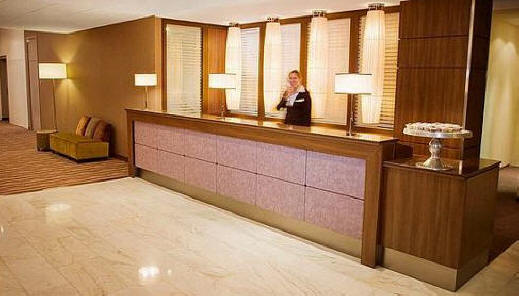
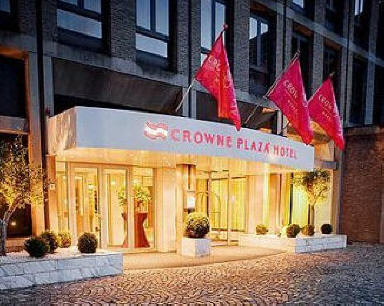
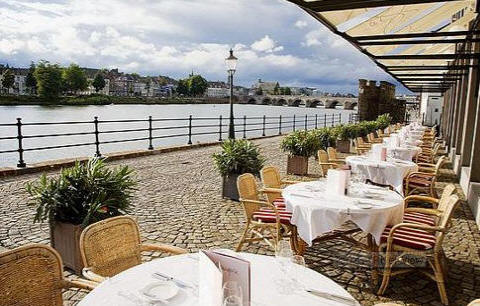
Above and below left are stock photos of the hotel and a beautiful shot of the hotel (lower left) all lit up and the Loop bridge at dusk. Below right was this access walk fortification to get down to the river.
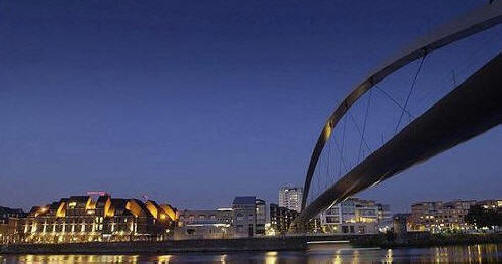
Below is a Photostitch shot of the river and loop bridge from near the hotel from the other side.
I headed back up Rechstraat and started looking in the store windows. I thought it a little shocking to see this in a art store window for children to see but the Netherlands is quite a "liberal" country.
In that regard, one controversial issue which has characterized Maastricht politics for years and which has also affected their national and even international politics, is the city's approach to the Dutch soft drug policy. This policy of non-enforcement allows individuals to buy and use cannabis (marijuana) under certain conditions from so-called "coffeeshops" (cannabis bars.) So be careful when looking for a coffee shop.
Maastricht, like many other border towns, has seen a growing influx of "drug tourists," mainly young people from Belgium and France, who provide a large amount of revenue for the coffee shops in the city center. The city government has been actively promoting drug policy reform in order to deal with its negative side effects. I wish them luck.
I describe this because I then came across just such a shop called Maxcy's [Rechtstraat 60a.] I usually try new things on these trips (like eating whale in Norway) but never having used marijuana, I wasn't going to start now, even if it was totally legal. For some reason I was very nervous taking pictures of the place and thus the blurry photo of the window sign warning that the age limit is 18 and ID is required to enter and "get a cup of coffee?"
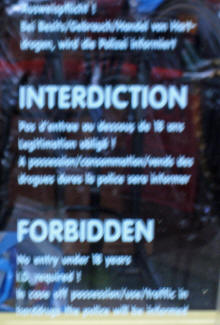
Beer and wine is enough for me and speaking
of that, I was really in the
 mood for a Guinness when I
just happened to come across this very
inviting John Mullins Pub [Wycker
Brugstraat 50,
mood for a Guinness when I
just happened to come across this very
inviting John Mullins Pub [Wycker
Brugstraat 50, ![]() +31-46-423-0070.] I stepped inside out of the rain and ordered a quiet pint
(below right.)
+31-46-423-0070.] I stepped inside out of the rain and ordered a quiet pint
(below right.)
Below are stock photos of the pub from their website. It looks like quite a neat place in the evening.
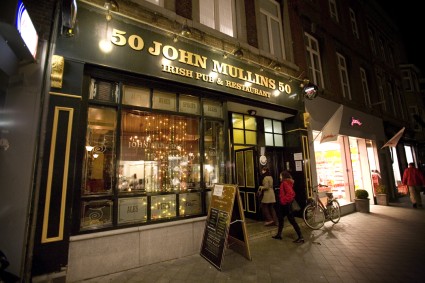
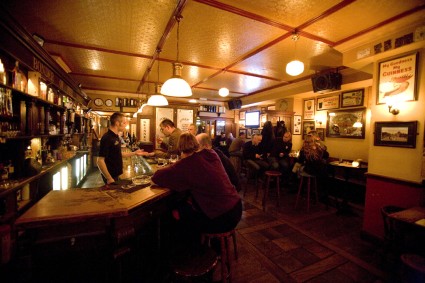
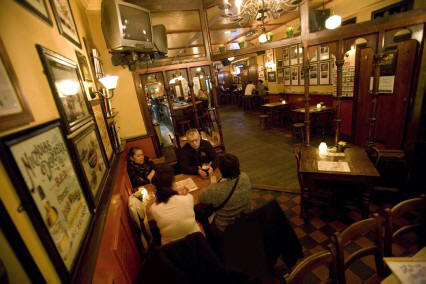
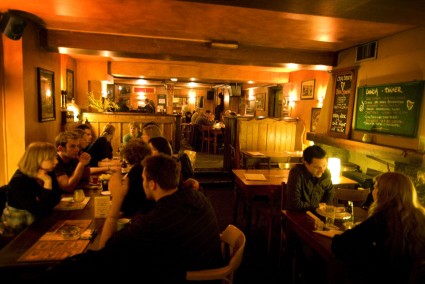
I relaxed awhile, hoping the rain might stop before heading back. I finished at 7:10 PM, and walked back to the hotel in the light rain (with umbrella) getting these great shots of the Sint Servaasbrug (St. Servaas bridge.) This first one is a stock panorama shot; the rest are mine.
.jpg)

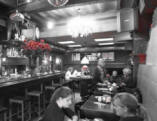 On
the way, I peaked inside a very cute little pub called Caf� Van Bommel [Platielstraat
13-15,
On
the way, I peaked inside a very cute little pub called Caf� Van Bommel [Platielstraat
13-15,
![]() +31-43-321-4400,
info@cafevanbommel.nl.] The
place was completely empty so I just took a picture and left.
+31-43-321-4400,
info@cafevanbommel.nl.] The
place was completely empty so I just took a picture and left.
I got back to the room and changed and then at 8:15 PM I discovered I had just lost �9 ($13) on an internet booking phone call that Michelle (at the hotel) had given me for another hotel. I wasn't too pleased.
Marcia and I then headed out and at 8:20 PM, we stopped for a cocktail at this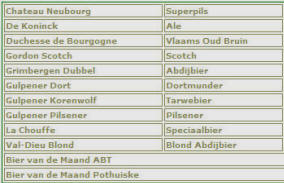 very cute little place along the river called
Caf� 't Pothuiske [Het Bat 1,
very cute little place along the river called
Caf� 't Pothuiske [Het Bat 1,
![]() +31-43-321-6002, info@pothuiske.nl] run
by Bert and Margareth, and we enjoyed a Neubourg beer and a Chardonnay.
They have a good list (right) of "bieren van het vat" (beers on tap) Don't ask me
how to pronounce these names but I did learn that "het" = "the."
+31-43-321-6002, info@pothuiske.nl] run
by Bert and Margareth, and we enjoyed a Neubourg beer and a Chardonnay.
They have a good list (right) of "bieren van het vat" (beers on tap) Don't ask me
how to pronounce these names but I did learn that "het" = "the."

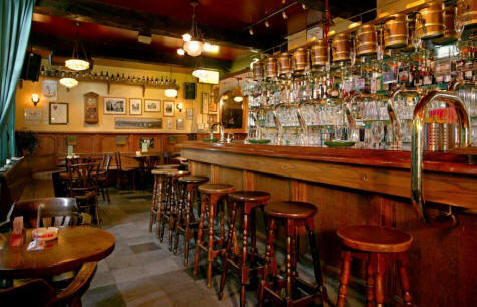
We relaxed and chatted with the proprietors. The beer was very good.
You can certainly see (above right) how stopping to park on one of these little streets pretty much blocks it off. Below is our trek across the bridge back to Rechstraat.
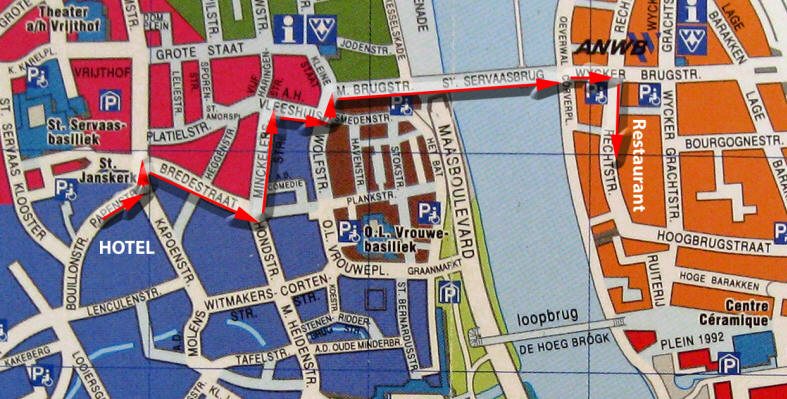
I was in the mood for Italian, so we decided to try one of the places I saw earlier and I convinced Marcia it
wasn't that far to walk. We arrived for dinner at 9:15 at Mediterraneo Ristorante [Rechtstraat
73, ![]() +31-43-325-5037.]
It was purely coincidental that we chose this place.
+31-43-325-5037.]
It was purely coincidental that we chose this place.
Marcia and I shared a bottle of Zenato Italian white wine and they brought us some bruschetta with mushrooms (left,) tomato (middle) and lardo (right.) Lardo is Italian pork fat, something I don't really enjoy but it is very popular in Italy.
For a starter, I had spaghetti alle vongole (look at that delicious pile of clams,) followed by an entree of a delicious bowl of raviole with ricotta and spinache.
Marcia started with a green salad and then had branzino (Mediterranean sea bass) with white asparagus and potatoes. For dessert we each had sorbet lemon vodka champagne. It was all excellent and we highly recommend it.
Now here is one of the most interesting encounters of our trip.
Before eating, I got up to take a picture of Marcia in the restaurant and a lady at the next table offered to take a photo of both of us, which she did nicely (below.)
Her name is Me�a Engelsma and she and her husband Wiberen ("Wilber") (below) are from Leeuwarden way up in the north of Netherland and they are here on a visit. This is one of their favorite restaurants. As we were talking, I happened to mention that I have been trying to reach Dr. Jan Worst, the famous Dutch eye surgeon I had visited in Groningen in 1974; 35 years ago. I told her I tried emails and old phone numbers and had no luck.
Then Me�a shocked me by telling me she is a long-time friend of Jan's wife Aneke and they are in a Dutch professional women's organization together. She said she had Aneke's cell phone number on her phone and then gave it to me. This allowed us to reach Jan and Aneke the next day and visit them later in the trip (August 21.) What an amazing coincidence! During our discussions they also recommended the Eden Hotels in the Netherlands [www.edenhotel.com] as well as the Grand Plaza Hotel [www.grandhotelplaza.nl.]
We left there very pleased with our dinner and our company and at 11:55 PM we ambled our way to Stationsstraat.
We ended up stopping in this place called
Tapperij De Poshoorn [Stationsstraat 47, ![]() +31-43-321-7334.] We joined in conversation with others at the bar and I ordered another Neubourg pels
(beer) and
Marcia had a wine. Then after a recommendation, I tried a glass of Gerardus Dubbel
Kloosterbier.
+31-43-321-7334.] We joined in conversation with others at the bar and I ordered another Neubourg pels
(beer) and
Marcia had a wine. Then after a recommendation, I tried a glass of Gerardus Dubbel
Kloosterbier.
Of course, we wound up meeting and talking to people. There was a gent (above and below) from the Dutch city of Amersfoort who recommended that we visit the city of Giethoorn.
We also met this black dog named Duke and a visitor from New Jersey who told me she was a patient of an optometrist, which of course led to some discussion of the difference between optoms and ophthalmologists. We had a good time.
We finally left and made our way back to the hotel and got to bed at 2 AM.
[TODAY (5/30/2010) IS OUR 40TH WEDDING ANNIVERSARY]
Kenneth J. Hoffer, MD
Maastricht, Nederlands
5-30-2010
If you enjoyed these travels or wish to add comments on the places we visited
Please Leave Me a Message by clicking the spinning @ sign.

